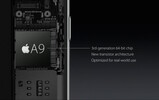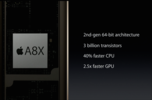Apple A9 vs Apple A8 vs Apple A8X
Apple A9
► remove from comparison
The Apple A9 is a high-end dual-core ARM SoC for smartphones. It was announced in Sept. 2015 in the new iPhone 6s and 6s Plus. Technical details were not published, but the CPU part should be about 70% and the GPU 90% faster than the previous Apple A8. Therefore, the performance should be on par with high-end Android SoCs in 2015.
It is based on the third generation of Apples 64 Bit architectures (Cyclone 3?) and uses a "new transistor technology". It is manufactured at Samsung in 14nm (slightly smaller die) and TSMC at 16nm (both FINFET 3D transistors). A performance difference of both versions are not noticable.
Furthermore, the chip now integrates the M9 motion coprocessor and a 4K video de- and encoder (as the iPhones 6s supports 4K video recording). The integrated graphics card should be still based on PowerVR technology.
The power consumption could be lower than the A8 due to the new process technology and the fact that the iPhones now got a smaller battery (due to the haptic engine part).
Apple A8
► remove from comparison
The Apple A8 is a high-end ARM SoC (System on a Chip) launched in September 2014 alongside the iPhone 6 and iPhone 6 Plus. The two CPU cores are clocked at 1.4 GHz (compared to the 1.3 GHz Apple A7) and are based on Apple's 2nd generation 64-bit architecture, called "Cyclone 2". Furthermore, the A8 integrates a PowerVR Series 6 (Rogue) GX6450 GPU and a 2x 32-bit LPDDR3-1333 memory controller.
Architecture
With Cyclone 2, Apple have managed to improve the already high performance per clock of the original Cyclone core (Apple A7) by another 10 to 15 percent. Neither Qualcomm's Krait nor ARM's Cortex-A57 can compete with the resulting IPC. The exact design changes have not been revealed, but we would expect enlarged caches and registers as well as an optimized branch prediction. As an ARMv8 architecture, Cyclone 2 is 64-bit capable.
Performance
Thanks to its impressive performance per clock, the Apple 1.4 GHz dual-core is a tough opponent for other high-end SoCs like the Nvidia Tegra K1 (4 cores @ 2.3 GHz) or Qualcomm Snapdragon 805 (4 cores @ 2.7 GHz). While the quad-core competitors win most multi-threaded benchmarks, the Apple A8 offers superior single-threaded performance, which is arguably more relevant for most everyday tasks like browsing. Overall, the A8 is one of the fastest smartphone SoCs as of late 2014.
Graphics
The SoC integrates a PowerVR Series 6 (Rogue) GX6450 GPU consisting of 4 clusters. Each cluster offers four FP16 and two FP32 ALUs, leading to a slightly higher shader performance than the former G6430. The core is predicted to be clocked relatively low at around 450 MHz (115 GFLOPS) to help reduce power consumption. According to our benchmarks, the GX6450 clearly outclasses the Adreno 330 in terms of 3D performance, but looses against Nvidia's more power hungry Tegra K1. Thus, the GX6450 is one of the fastest smartphone GPUs as of 2014 and can handle even the most demanding mobile games in high resolutions.
Power Consumption
In contrast to previous Apple SoCs, the A8 is manufactured by TSMC instead of Samsung. Using a brand-new 20 nm process, the SoC measures just 89 mm² and consists of about 2 billion transistors. Power consumption should be similar to or slightly below competing high-end SoCs by Qualcomm or Samsung.
Apple A8X
► remove from comparison
The Apple A8X is a high-end ARM SoC (System on a Chip) introduced in October 2014 alongside the iPad Air 2. The three CPU cores are clocked slightly higher than the two inside the Apple A8 (+100 MHz). Apple claims a 40% improvement over the 1.3 GHz Apple A7 compared to just 20% from the A8. Furthermore, the A8X integrates a much more powerful GPU (2x 4-core PowerVR Series 6XT (Rogue) GXA6850) as well as a 128-bit LPDDR3 memory controller.
Architecture
With Cyclone 2, Apple has managed to improve the already high performance-per-clock of the original Cyclone core (Apple A7) by another 10 to 15 percent. Neither Qualcomm's Krait nor ARM's Cortex-A57 can compete with the resulting IPC. The exact design changes have not been revealed, but we would expect enlarged caches and registers as well as an optimized branch prediction. As an ARMv8 architecture, Cyclone 2 is 64-bit capable.
Performance
Compared to the previous Apple A7, the A8X offers about 20 - 70 percent more performance. Especially the multi-thread performance has been significantly improved thanks to the third CPU core, whereas the single-thread power is just slightly higher (~20 percent). According to Geekbench 3 scores, the A8X is the fastest mobile ARM-SoC as of late 2014. However, the chip clearly benefits from the 64-bit support in the iOS version of the benchmark. Without this advantage, Nvidia's Tegra K1 (Denver) dual-core is still somewhat faster in single-thread software (but slower in multi-thread tests).
Graphics
In contrast to previous speculations, the A8X integrates an 8-cluster PowerVR Series 6 (Rogue) GXA6850 consisting of two GX6450 GPUs (2x 4 clusters) instead of a single GX6650 (6 clusters). The name GXA6850 has been created by Anandtech, the design may also be called a GX6450MP2.
Each cluster offers four FP16 and two FP32 ALUs, leading to a compute power of about 230 GFLOPS FP32 at 450 MHz (clock rate estimated). The GXA6850 does not only beat the Qualcomm Adreno 420 (Snapdragon 805), but also the Nvidia Tegra K1 by a small margin. Thus, the GXA6850 is one of the fastest tablet GPUs as of 2014 and can handle even the most demanding mobile games in high resolutions. Among others, the GPU supports OpenGL 3.x/4.x, OpenGL ES 3.0 as well as DirectX 10.
Power Consumption
In contrast to previous Apple SoCs, the A8 und A8X are manufactured by TSMC instead of Samsung. Using a brand-new 20 nm process, the SoC consists of a whopping 3 billion transistors. Power consumption should be similar to competing high-end SoCs by Qualcomm or Samsung.
| Model | Apple A9 | Apple A8 | Apple A8X | ||||||||||||||||||||||||
| Series | Apple | Apple | Apple | ||||||||||||||||||||||||
| Codename | Cyclone 3 | Cyclone 2 | Cyclone 2 | ||||||||||||||||||||||||
| Series: Cyclone 2 |
|
|
| ||||||||||||||||||||||||
| Clock | 1800 MHz | 1400 MHz | 1500 MHz | ||||||||||||||||||||||||
| Cores / Threads | 2 / 2 | 2 / 2 | 3 / 3 | ||||||||||||||||||||||||
| Technology | 14/16 nm | 20 nm | 20 nm | ||||||||||||||||||||||||
| Features | ARMv8 Instruction Set | ARMv8 Instruction Set, PowerVR GX6450 (4 Cluster Rogue), 2x 32 Bit LPDDR3-1333 Memory Controller | ARMv8 Instruction Set, PowerVR GXA6850 (2x 4 Cluster Rogue), 128 Bit LPDDR3 Memory Controller | ||||||||||||||||||||||||
| iGPU | Apple A9 / PowerVR GT7600 | PowerVR GX6450 | PowerVR GX6650 | ||||||||||||||||||||||||
| Architecture | ARM | ARM | ARM | ||||||||||||||||||||||||
| Announced | |||||||||||||||||||||||||||
| L1 Cache | 256 KB | 384 KB | |||||||||||||||||||||||||
| L2 Cache | 1 MB | 2 MB | |||||||||||||||||||||||||
| L3 Cache | 4 MB | 4 MB | |||||||||||||||||||||||||
| Transistors | 2000 Million | 3000 Million | |||||||||||||||||||||||||
| Die Size | 89 mm2 | 128 mm2 |


 Deutsch
Deutsch English
English Español
Español Français
Français Italiano
Italiano Nederlands
Nederlands Polski
Polski Português
Português Русский
Русский Türkçe
Türkçe Svenska
Svenska Chinese
Chinese Magyar
Magyar
